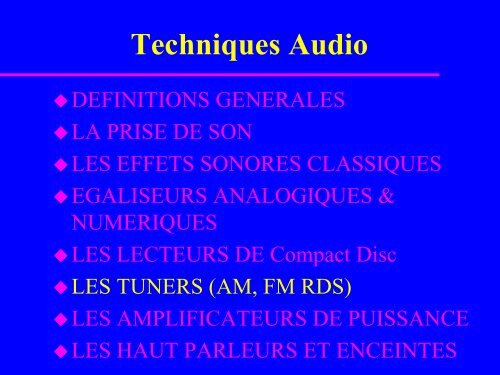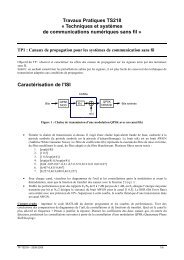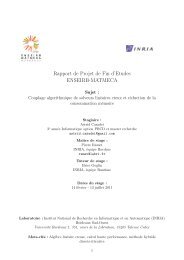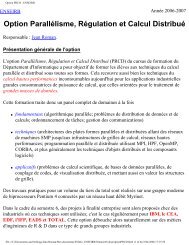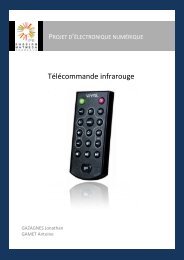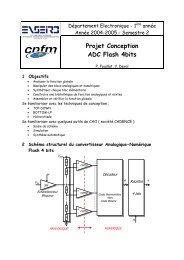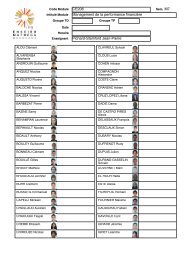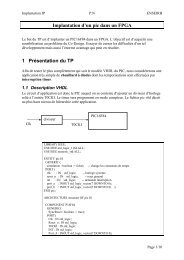LES TUNERS et le RDS (Radio Data System) - Uuu.enseirb.fr
LES TUNERS et le RDS (Radio Data System) - Uuu.enseirb.fr
LES TUNERS et le RDS (Radio Data System) - Uuu.enseirb.fr
- No tags were found...
Create successful ePaper yourself
Turn your PDF publications into a flip-book with our unique Google optimized e-Paper software.
TECHNIQUES AUDIO6.2 <strong>LES</strong> <strong>TUNERS</strong>, Récepteur radio grand publicSynoptique d’un récepteurmélangeurampliRFXampli F.Idémodulateurampliaudiooscillateurloca<strong>le</strong>n FM : FI =10,7 MHzen AM : FI = 455 kHzRécepteur superhétérodyne
TECHNIQUES AUDIO6.2 <strong>LES</strong> <strong>TUNERS</strong>, Récepteur radio grand publicChoix de la <strong>fr</strong>équence intermédiaire réjection de la <strong>fr</strong>équence imageF min = 88MHzFrFr = FI-Fol ou Fr’ = Fol+FIXFmax−FminFi >2Fr’Fmax = 108MHzFOLD’où <strong>le</strong>s va<strong>le</strong>urs de FIAM <strong>et</strong> FM
TECHNIQUES AUDIO6.2 <strong>LES</strong> <strong>TUNERS</strong>, Récepteur radio grand publicComparaison Récepteur AM <strong>et</strong> FMAM : nécessite une correction automatique degain (CAG) pour annu<strong>le</strong>r <strong>le</strong>s variationsd’amplitude dues à la propagation (fading)FM : nécessite une correction automatique de<strong>fr</strong>équence pour maintenir la FI centrée sur laplage du discriminateur en cas de dérive del’OL réception
TECHNIQUES AUDIO6.2 <strong>LES</strong> <strong>TUNERS</strong>, Récepteur radio grand publicQuelques récepteurs intégrés du commerceTDA 1574 (récepteur FM compl<strong>et</strong>)TDA 1576 (circuit FM FI+demod)TDA 1072A (récepteur AM)
TECHNIQUES AUDIO6.1 <strong>LES</strong> <strong>TUNERS</strong>, récepteurs grand publicPrincipe de la stéréo FMpilote à 19 kHzG+Dmono G-D G-D0 15 19 23 38 53 Fréquence (kHz)signal composite émis
TECHNIQUES AUDIO6.1 <strong>LES</strong> <strong>TUNERS</strong>, récepteurs grand publicPrincipe du codeur stéréo FMGDétagelimiteurétagelimiteurMatrice+/-(G+D)(G-D)Xpasse bas15 kHzpasse bande23-53 kHzadditionsortiecompositeadditionoscillateur38 kHzdiv /2filtre19 kHz
TECHNIQUES AUDIO6.1 <strong>LES</strong> <strong>TUNERS</strong>, récepteurs grand publicprincipe du décodeur FM stéréosignalcompositepasse bas15 kHzpasse bande23-53 kHzfiltre pilote19 kHz(G+D)doub<strong>le</strong>ur(x2)Matrice+/-X(G-D)démodulateursynchrone38 kHz(G+D)+(G-D)=2Gsortie stéréo(G+D)-(G-D)=2D
TECHNIQUES AUDIO6.3 <strong>LES</strong> <strong>TUNERS</strong>, fonctions principa<strong>le</strong>sRéalisation des principa<strong>le</strong>s fonctions :- Mélangeur- Oscillateur local- Démodulateur FM- Correction automatique de gain (AM)- Correction automatique de <strong>fr</strong>équence (FM)- Recherche automatique de station
TECHNIQUES AUDIO6.3.1 <strong>LES</strong> <strong>TUNERS</strong>, mélangeur
TECHNIQUES AUDIO6.3.2 <strong>LES</strong> <strong>TUNERS</strong>, oscillateur local
TECHNIQUES AUDIO6.3.3 <strong>LES</strong> <strong>TUNERS</strong>, démodulateur FMA coïncidence (ex : Motorola M 3357)limiteurd'amplitudeiuClcomparateurde phasepasse bassortiedémoduléeCRLvréseaudéphaseur accordé sur FI
TECHNIQUES AUDIO6.3.3 <strong>LES</strong> <strong>TUNERS</strong>, démodulateur FMà PLL (phase locked loop)F.I modulée2π/pφecomparateurde phaseXKcUcfiltrepasse basG(p)Sortie démoduléeUvKvVCOFs2π/pφs
TECHNIQUES AUDIO6.3.4 <strong>LES</strong> <strong>TUNERS</strong>, CAG
TECHNIQUES AUDIO6.3.4 <strong>LES</strong> <strong>TUNERS</strong>, CAF
TECHNIQUES AUDIO6.3.4 <strong>LES</strong> <strong>TUNERS</strong>, recherche auto de stationRFPrincipeX ampli F.I démodulateursynthétiseurcontrolé en tensiongénérateur derampe de tensionoscillateur localaffichage<strong>fr</strong>équenceconvertisseurN/Aampliaudiomesure deniveauarrêt sur stationou aff.«notcompteur found»cycliquelancement cyc<strong>le</strong> de recherche (seek)
TECHNIQUES AUDIO6.4 <strong>LES</strong> <strong>TUNERS</strong>, <strong>Radio</strong> <strong>Data</strong> <strong>System</strong>Fonctionnalités du <strong>Radio</strong> <strong>Data</strong> <strong>System</strong> (1987) Identification de la station Sé<strong>le</strong>ction du type de programme (jazz, sport...) Changement automatique de <strong>fr</strong>équence poursuivi d’une station d’une zone géographique àl’autre Information (news), trafic routier (TA) <strong>et</strong>c.norme <strong>RDS</strong> EN50067 CENELEC (rev 1996)
TECHNIQUES AUDIO6.4 <strong>LES</strong> <strong>TUNERS</strong>, <strong>RDS</strong><strong>Radio</strong> <strong>Data</strong> <strong>System</strong> : Sous porteuse <strong>RDS</strong> : harmonique 3 (57kHz) dupilote 19 kHz Modulation d’amplitude avec suppression deporteuse par <strong>le</strong> signal uti<strong>le</strong> codé biphase. Débit normalisé : 1187,5 bit/sec Format de donnée : 26 bits dont 10 de contrô<strong>le</strong>(<strong>RDS</strong> BLOCK) Format : <strong>RDS</strong> GROUP = 4 <strong>RDS</strong> BLOCKS.
TECHNIQUES AUDIO6.4 <strong>LES</strong> <strong>TUNERS</strong>, <strong>RDS</strong>Spectre du signal Stéréo <strong>et</strong> <strong>RDS</strong>pilote à 19 kHzG+Dmono G-D G-D57 kHzmodulé en amplitudeextensions futures0 15 19 23 38 53 57 Fréquence (kHz)signal composite émis
TECHNIQUES AUDIO6.4 <strong>LES</strong> <strong>TUNERS</strong>, <strong>RDS</strong>Principe de repérage d’un programmeentréeclaviermémorisation de la configurationutilisateurScrutation permanentede la bande FMDétection programme(news, TA...)R<strong>et</strong>our auto à la stationprése<strong>le</strong>ctionnée F1Ecoute de la stationprésé<strong>le</strong>ctionnée F1Commutation sur lanouvel<strong>le</strong> station FnDétection fin deprogramme
TECHNIQUES AUDIO6.4 <strong>LES</strong> <strong>TUNERS</strong>, <strong>RDS</strong>Principe de changement de zoneZONE 1ZONE 2auto radio <strong>RDS</strong>2 récepteurs en un !
TECHNIQUES AUDIO6.4 <strong>LES</strong> <strong>TUNERS</strong>, <strong>RDS</strong>Principe de changement de zone (Seek)Objectif : rester à l’écoute de la station FMchoisie même si l’on change d’ém<strong>et</strong>teurLe récepteur principal est calé sur la station S1<strong>et</strong> la Fréquence F1Le second scrute la bande FM jusqu’à identifierla même station sur la <strong>fr</strong>équence F2Comparaison des niveaux reçus <strong>et</strong> accrochagesur l’ém<strong>et</strong>teur <strong>le</strong> plus fort
TECHNIQUES AUDIO6.4 <strong>LES</strong> <strong>TUNERS</strong>, <strong>RDS</strong>Glossaire : AF - Alternative Frequencies list : donne une information sur<strong>le</strong>s différentes stations diffusant <strong>le</strong> même programme dans lamême région ou une adjacente, <strong>et</strong> autorise <strong>le</strong>s récepteurséquipés avec une mémoire à stocker la liste, pour réduire l<strong>et</strong>emps de commutation sur une autre station. CT - Clock Time and date : <strong>le</strong> code temps <strong>et</strong> date utilise <strong>le</strong>Coordinated Universal Time (UTC)
TECHNIQUES AUDIO6.4 <strong>LES</strong> <strong>TUNERS</strong>, <strong>RDS</strong>Glossaire (suite): DI - Decoder Identification and dynamic PTY indicator : cesbits indiquent <strong>le</strong>s modes de fonctionnement possib<strong>le</strong> <strong>et</strong>approprié pour l’utilisation avec <strong>le</strong>s programmes audio <strong>et</strong>indiquent si <strong>le</strong> code PTY est commuté dynamiquement. ECC - Extended Country Code : <strong>RDS</strong> utilise ses propres codespays. Sa structure sur 4 bits perm<strong>et</strong> seu<strong>le</strong>ment la définition de15 différents codes. Comme il y a plus de 15 pays à identifier,certain pays partagent <strong>le</strong> même code, ce qui ne perm<strong>et</strong> pas uneidentification unique. Il est donc nécessaire d’utiliser l’ExtendedCountry Code (ECC).
TECHNIQUES AUDIO6.4 <strong>LES</strong> <strong>TUNERS</strong>, <strong>RDS</strong>Glossaire (suite): EON - Enhanced Other N<strong>et</strong>works information : Ce code peutêtre utilisé pour m<strong>et</strong>tre à jour <strong>le</strong>s informations stokées dans unrécepteur sur <strong>le</strong>s «programme services» autres que celui reçu. EWS - Emergency Warning <strong>System</strong> : utilisé pour délivrer desmessages d’a<strong>le</strong>rte. Ces messages seront diffusés seu<strong>le</strong>ment en casd’urgence <strong>et</strong> reçus par des récepteurs spéciaux.
TECHNIQUES AUDIO6.4 <strong>LES</strong> <strong>TUNERS</strong>, <strong>RDS</strong>Glossaire (suite): IH - In House application : données décodab<strong>le</strong>s que par <strong>le</strong>sopérateurs (voie de service). M/S - Music/Speech switch : signal deux états qui indique si onrecoit de la musique ou de la paro<strong>le</strong>. Ce signal perm<strong>et</strong>tra -pour<strong>le</strong>s récepteurs équipés avec deux réglages séparés du volume (unpour la musique, un pour la paro<strong>le</strong>)- à l’auditeur d’ajuster <strong>le</strong>sniveaux en fonction de ses gouts.
TECHNIQUES AUDIO6.4 <strong>LES</strong> <strong>TUNERS</strong>, <strong>RDS</strong>Glossaire (suite): ODA - Open <strong>Data</strong> Applications : perm<strong>et</strong> des applications, nonspécifiées dans l’EN 50067. Transmission de données dans desgroupes alloués <strong>et</strong> réservés. PI - Programme Identification : consists of a code enabling thereceiver to distinguish b<strong>et</strong>ween countries, areas in which thesame programme is transmitted, and the identification of theprogramme itself. The code is not intended for direct displayand is assigned to each individual radio programme, to enab<strong>le</strong> itto be distinguished <strong>fr</strong>om all other programmes.
TECHNIQUES AUDIO6.4 <strong>LES</strong> <strong>TUNERS</strong>, <strong>RDS</strong>Glossaire (suite): TA - Traffic announcement identification : This is an on/offswitching signal to indicate when a traffic announcement is onair. It could be used in receivers to:- switch automatically <strong>fr</strong>om any audio mode to the trafficannouncement;- switch on the traffic announcement automatically when thereceiver is in a waiting mode and the audio signal is muted;- switch <strong>fr</strong>om a programme to another one carrying a trafficannouncement, according to possibilities availab<strong>le</strong> throughEON. After the end of the traffic announcement, the initial operatingmode will be restored.


